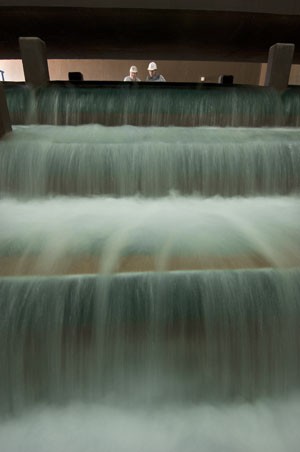
To prosper, Jordan must optimize the use of all available water resources. To this end, the country is capturing water from brackish streams that would otherwise go unused, and delivering 125,000 cubic meters (4.4 million cubic feet) of water a day to a USAID-funded water treatment plant.
The Wadi Ma’in, Zara and Mujib water treatment and conveyance project is supplying water for a population of 700,000 people — about one third of the water distributed in the Greater Amman area.
The treatment plant removes suspended solids and microbiological contaminants through coagulation, settling and filtering. At this point, the water is pure enough to drink, but still has a high salt content. The next process is reverse osmosis, through which the water is pumped through membranes with openings so fine that the water molecules pass through, but the salt ions cannot. About 85 percent of the water is recovered as pure water and the remaining 15 percent, which carries all of the salt, is discharged to the Dead Sea.
The project delivers 100,000 cubic meters of water (more than 3.5 million cubic feet) each day to Amman, a distance of 40 kilometers (approximately 25 miles).
Aside from contributing pure water to Amman, the project also aims to accomplish four other goals. It will reduce overpumping of groundwater aquifers, to allow them to recover their full storage capacity as a reserve against future shortages. It will release water currently being pumped to Amman from other cities, in order to promote development in those outlying cities. It provides higher quality wastewater; when mixed with low-quality water from other sources, this results in more treated wastewater available for irrigation. Finally, it has fostered employment and economic development in the Kingdom, with up to 1,500 jobs during the plant’s construction and 100 permanent jobs running the project facilities.







Comment
Make a general inquiry or suggest an improvement.